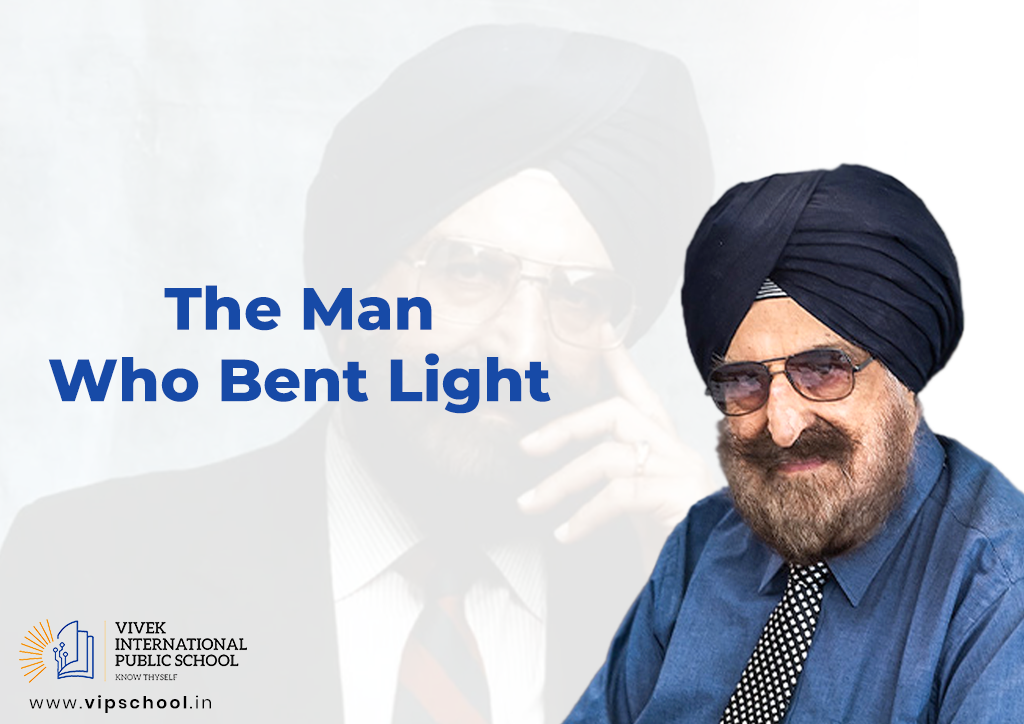News & Events
The Man Who Bent Light: Narinder Singh Kapany

Before the invention of fibre optics, communication and data transfer relied on copper wires and radio waves, methods that had limitations in terms of bandwidth and efficiency. However, with the advent of fibre optics, which used thin strands of glass to transmit data through light signals, things changed dramatically.
It made high-speed internet, telecommunication and even medical imaging possible. But do you know the man who invented fibre optics? You will be surprised and proud to learn that an Indian American Physicist, Narinder Singh Kapany, was behind this groundbreaking research. We have curated this article to help you know everything about him, from his early life to his pioneering work. But before that, let us first understand why researchers use glass as a medium for transmitting light signals.
Glass as a Medium
Glass serves as a medium for fibre optics because of its unique properties, which include its ability to transmit light signals without any significant loss and distortion. While glass fibre experimentation was in its initial stages, researchers sought methods to improve reflection and reduce signal loss over long distances and came up with many methods, which included coating the fibres with thin metal layers and many more.
However, after researchers discovered total internal reflection, a phenomenon in which light rays bounce continuously within the core of the fibre, allowing the light to remain confined without escaping, new possibilities for transmitting light signals through glass fibre opened.
Do you know what keeps your internet fast and reliable? It’s the total internal reflection.
The Inventor - Dr Narinder Singh Kapany
Dr Narinder Singh Kapany, the man who demonstrated that optical signals can be sent through glass fibre, was born on 31st October 1926 in the small town of Moga in Punjab. He was curious from an early age, and his passion for learning made him explore light and materials as he grew. After completing his schooling at Dehradun and graduating from Agra University, he went to London to pursue higher studies. He completed his PhD in optics from the Imperial College of London in 1955.
While working on his PhD under Harold Hopkins, he successfully transmitted light through the glass fibre. At that time, the scientific community believed that light couldn’t be bent, but Kapany proved the opposite of it. In an article published in Scientific American, Kapany coined the term "fibre optics". He also wrote a book on this new field and is one of the most prominent researchers and writers in this field. Also, his work was not only limited to fibre optics but also extended to lasers, biomedical instrumentation, and several other distinguished fields. He had over 100 patents in solar energy, biomedical instrumentation, pollution monitoring and more.
His Career after the Invention
Kapany founded Optics Technology, Inc., in 1960, which became the first company to bring fibre optic products to the market. The company initially made coating, lenses, and endoscopes for the military and the Industries. However, after going public, they provided their products to a wide range of customers, including commercial industries and international markets.
In 1977, Kapany started a new company, Kaptron, to enhance long-distance communication through fibre optics and supply its products to telecom companies such as AT&T, Northern Telecom and more. He sold the company to AMP incorporated in 1990, but remained the head of the Entrepreneur & Technical Program for the next nine years. On the academic front, he taught postgraduate students and supervised their research activities. He was a visiting scholar at Stanford University and a professor at the University of California in Berkeley and Santa Cruz.
Also read about the National Awards of India
Cultural Ambassador
Kapany was a committed educator and philanthropist who worked for education and cultural preservation. He and his wife established the Sikh Foundation in 1967, which aimed to promote and preserve Sikh culture and heritage. They also did various things to ensure the Sikh's glorious history received its share in the global community, from helping to establish a Sikh art collection at the Asian Art Museum in San Francisco to support various other cultural activities.
Despite the work that Kapany did in education and cultural promotion, he did not receive the recognition that he deserved. You may be surprised to know that his name is not even mentioned in textbooks, which means that top CBSE schools in Baddi may not provide you with any information about him. Fortunately, you can explore more about him on the internet. Fortune magazine named him among the seven unsung heroes in their "Businessman of the Century" issue in the year 1999. He also received Pravasi Bharatiya Samman from the Government of India in 2004.
Conclusion
So, this was all about legendary physicist Narinder Singh Kapany. While it is impossible to cover every aspect of his work as it extends to various fields, we have tried to give you an insight into his remarkable contribution to fibre optics. Next time, whenever you use the internet, don’t forget to appreciate the man behind this- Narinder Singh Kapany, who laid the foundation of high-speed communication.

